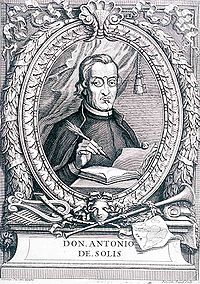
Antonio de Solís y Ribadeneyra
Encyclopedia

Spain
Spain , officially the Kingdom of Spain languages]] under the European Charter for Regional or Minority Languages. In each of these, Spain's official name is as follows:;;;;;;), is a country and member state of the European Union located in southwestern Europe on the Iberian Peninsula...
dramatist and historian. His work includes drama, poetry, and prose, and he has been considered one of the last great writers of Spanish Baroque literature
Spanish Baroque literature
Spanish Baroque literature is the literature written in Spain during the Baroque.The literary Baroque took place in Spain in the middle of the Golden Age of Spanish Literature. Spain was governed in that period by Philip II, Philip III and Philip IV, the last reigning until 1665.During the previous...
.
He was born at Alcalá de Henares
Alcalá de Henares
Alcalá de Henares , meaning Citadel on the river Henares, is a Spanish city, whose historical centre is one of UNESCO's World Heritage Sites, and one of the first bishoprics founded in Spain...
(or, less probably, Plasencia). He studied law
Law
Law is a system of rules and guidelines which are enforced through social institutions to govern behavior, wherever possible. It shapes politics, economics and society in numerous ways and serves as a social mediator of relations between people. Contract law regulates everything from buying a bus...
at Salamanca
Salamanca
Salamanca is a city in western Spain, in the community of Castile and León. Because it is known for its beautiful buildings and urban environment, the Old City was declared a UNESCO World Heritage Site in 1988. It is the most important university city in Spain and is known for its contributions to...
, where he produced a comedy entitled Amour and Obligation, which was acted in 1627. He became secretary to the count of Oropesa, and in 1654 he was appointed secretary of state as well as private secretary to Philip IV
Philip IV of Spain
Philip IV was King of Spain between 1621 and 1665, sovereign of the Spanish Netherlands, and King of Portugal until 1640...
. Later he obtained the lucrative post of chronicler of the Indies, and, on taking orders in 1671 severed his connexion with the stage. He died at Madrid
Madrid
Madrid is the capital and largest city of Spain. The population of the city is roughly 3.3 million and the entire population of the Madrid metropolitan area is calculated to be 6.271 million. It is the third largest city in the European Union, after London and Berlin, and its metropolitan...
on April 19, 1686.
His Work
Of his ten extant plays, two have some place in the history of the drama. El Amor al uso was adapted by ScarronPaul Scarron
Paul Scarron was a French poet, dramatist, and novelist. His precise birthdate is unknown, but he was baptized on July 4, 1610...
and again by Thomas Corneille
Thomas Corneille
Thomas Corneille was a French dramatist.- Personal life :Born in Rouen nearly twenty years after his brother Pierre, the "great Corneille", Thomas's skill as a poet seems to have shown itself early. At the age of fifteen he composed a play in Latin which was performed by his fellow-pupils at the...
as L'Amour de la mode, while La Gitanilla de Madrid, itself founded on the novela of Cervantes
Miguel de Cervantes
Miguel de Cervantes Saavedra was a Spanish novelist, poet, and playwright. His magnum opus, Don Quixote, considered the first modern novel, is a classic of Western literature, and is regarded amongst the best works of fiction ever written...
, has been utilized directly or indirectly by PA Wolff, Victor Hugo
Victor Hugo
Victor-Marie Hugo was a Frenchpoet, playwright, novelist, essayist, visual artist, statesman, human rights activist and exponent of the Romantic movement in France....
and Longfellow
Henry Wadsworth Longfellow
Henry Wadsworth Longfellow was an American poet and educator whose works include "Paul Revere's Ride", The Song of Hiawatha, and Evangeline...
.
The titles of the remaining seven are Triumph from Armor and Fortune, Eurídice y Orfeo, The Alcetzar del secretion, The Amazons, The Doctor Carlino, Un bobo hace ciento, and Defend the Enemy. Amor y obligación survives in a manuscript at the Biblioteca Nacional.
The Historia de la conquista de México, población y progresos de la América septentrional, conocida por el nombre de Nueva España, covering the three years between the appointment of Cortés
Hernán Cortés
Hernán Cortés de Monroy y Pizarro, 1st Marquis of the Valley of Oaxaca was a Spanish Conquistador who led an expedition that caused the fall of the Aztec Empire and brought large portions of mainland Mexico under the rule of the King of Castile in the early 16th century...
to command the invading force and the fall of the city, deservedly ranks as a Spanish prose classic. It was first published in 1684 in Spain. French and Italian translations were published by the 1690s, and an English translation by Townshend appeared in 1724. The book was extremely popular on both sides of the Atlantic and was known to important figures in colonial Latin America and the British colonies. It remained the most important European source on Latin American history up through the first part of the nineteenth century.

